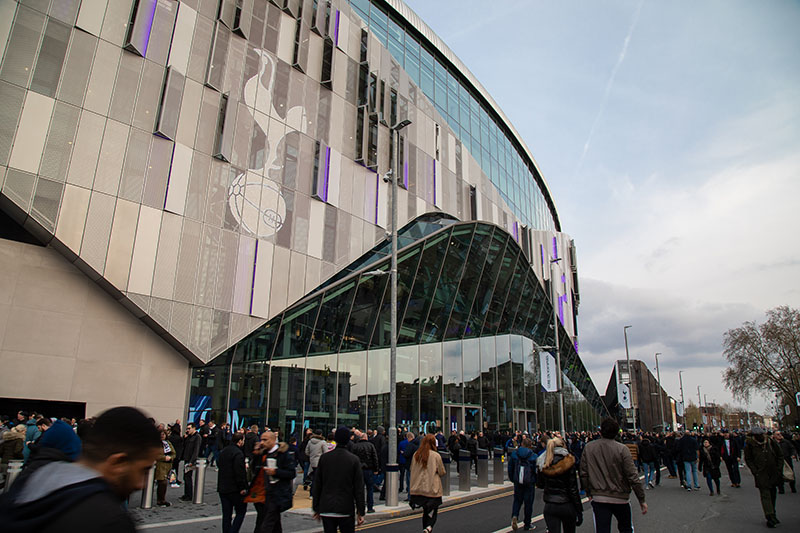
The regeneration of the area is undoubtedly impressive, but as one research project has found, not all local residents and businesses are benefiting from the sweeping changes
13 May ~ Tottenham Hotspur’s majestic new £1 billion home has rightly received plenty of rave reviews since its opening last month – a defining moment in what has been a long, protracted and at times controversial project.
It’s hard to argue against chairman Daniel Levy’s claim, made on the eve of the new ground’s debut that the club had “delivered an iconic stadium”. However, reports on the latest spectacular addition to the London skyline have reflected the stories of the local residents and businesses affected by the stadium and the linked wider regeneration plans for the area led by Haringey Council.
Mark Panton, an academic from Birbeck College’s Sports Business Management School, spent three years, between 2012 and 2015, charting the experiences of many of those living and working in the shadow of the old White Hart Lane on the opposite side of Tottenham High Road and directly affected by the plans for the new stadium and the wider regeneration as they evolved.
Set within a broader critique of sports-stadium-led regeneration projects across the world, Panton’s PhD research, uniquely chronicled in a graphic comic book, looks at the impact of both projects on those groups and individuals. His research also explored the club’s standing within the local community and relationship with its council, which is one of the most deprived local authorities in the capital.
Panton draws clear parallels between Tottenham’s stadium-led regeneration project and others worldwide, with the displacement of existing residents and businesses along with the gentrification of existing neighbourhoods all common themes: “They all involve demolition and nearly always involve people or businesses being moved out of their areas. Some of the individual issues get lost among the big planning and this often means that people get left behind,” he says.
The title of his book, Tottenham’s Trojan Horse? which he co-authored with Amanda Lillywhite, was a reflection of how local residents and community groups he worked with came to define their perception of the new stadium. “The idea that the stadium would become a Trojan horse for the gentrification of Tottenham and the local area was a comment I kept hearing from residents and community groups during the time I spent with them. You could argue there is a gentrification process going on both outside and inside the stadium, when you look at the impact the increased ticket prices will have as the club try to recoup the costs of the project.”
While some of these issues are common to many urban stadium-led regeneration projects, in Tottenham’s case there were also a unique set of circumstances, which help tell the story of how the new stadium was eventually completed. The Tottenham riots in 2011, the club’s unsuccessful bid for the Olympic Stadium which threatened to take away the area’s largest employer, landowner and most important institution along with the impact of austerity which has seen local councils such as Haringey become more reliant on private developers to assist with regeneration projects were all important factors.
Panton’s research acknowledges those issues and suggests that they played a part in the significant reduction in the projected 106 contributions for affordable housing, local infrastructure and other community benefits made by the club to the council as part of the planning agreement for the construction of the new stadium.
Although the stadium is now operating and providing many of the local benefits promised by the club in terms of jobs (and, one might assume, increased matchday revenues for local pubs, food vendors and retail outlets), local residents and businesses still feel a sense of uncertainty. “A Plan for Tottenham”, Haringey Council’s proposals for the wider surrounding area, include the demolition of social housing and the Peacock industrial estate (home to around 70 small local businesses) to allow for a new walkway for fans between White Hart Lane station and the stadium.
The community groups, businesses and residents affected by the proposals – a number of who identify as fans of the club – continue to battle for their voices to be heard as the council’s plans evolve. Indeed, Panton views the mobilisation of a relatively disparate local community as one of the more positive impacts of the stadium saga.
Anyone who has stepped foot inside Tottenham’s new home will not fail to be impressed by the way in which it has set a benchmark for the development of new stadiums. However, it is also a timely reminder that when it comes to projects of this scale there are always some losers among the obvious winners.
To find out more about Mark Panton’s research visit tottenhamstrojanhorse.blogspot.com
Photo by Colorsport
This article first appeared in WSC 387, June 2019. Subscribers get free access to the complete WSC digital archive – you can find out more here
